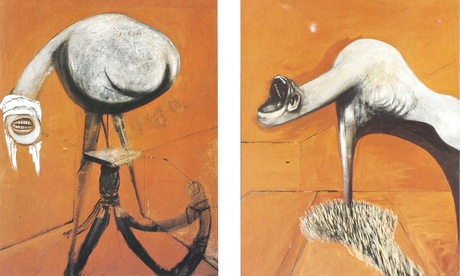Life and work of Francis Bacon to be celebrated in new institute in Monaco

Detail from Francis Bacon's Three Studies for Figures at the Base of a Crucifixion, 1944 Photograph: Tate
A unique scholarly institute devoted to Francis Bacon is to open in Monaco, where the painter drew inspiration from the light and landscape, as well as the principality’s gambling dens and bars.
The idea of the wealthy Lebanese-born property developer Majid Boustany, the Francis Bacon MB Art Foundation’s collection will bring together previously unseen photographs, oil paintings from the 1920s to the 1980s, and furniture and rugs from Bacon’s spell as an interior designer. There will also be an extensive library open to scholars and members of the public by appointment.
“It’s a unique collection of photographs, some never seen,” Boustany said.
A Swiss national who has lived in Monaco for 30 years, he owns Monte Carlo’s Hotel Metropole and says he had an epiphany 20 years ago when, as a student in London, he visited the Tate and found himself transfixed by the triptych, Three Studies for Figures at the Base of a Crucifixion. He went on to spend years collecting 2,000 items relating to the artist. He told the Observer: “My fascination for this uncompromising, compelling and controversial artist led me to immerse myself into Bacon’s world … Getting under his skin for so long led me to realise that something had to come out of that.”
The Francis Bacon Estate was initially wary of the project, but now leading art historian Martin Harrison, editor of the definitive Bacon Catalogue Raisonné, has joined the board. The official opening in October will be attended by the Prince of Monaco.
Harrison told the Observer: “He seemed too good to be true. Everyone was a bit sceptical … They checked Boustany out. His family … are philanthropists and they give scholarships in business studies to Harvard and Cambridge each year. Everything checked out … He spends about 24 hours a day working on Bacon!” Bacon had a passion for the climate, characters and casinos of the Côte d’Azur, saying that Monaco was “very good for pictures falling ready-made into the mind”. The gambling palace also proved a major source of funds on occasion.
Bacon lived and worked in Monaco from mid-1946 to the early 1950s, repeatedly returning to the principality and the Riviera throughout his life, “drifting from luxury hotel to luxury hotel, eating and drinking too much”. He said of Monte Carlo: “It has a kind of grandeur, even if you might call it grandeur of futility. There is something so beautiful about the view you get from the casino when you look out on the bay and the curve of the hills behind. I love that kind of landscape.”
Boustany said: “Although few people know of Bacon’s time in Monaco, there is a legitimate reason for housing the Bacon Foundation in the principality. It was in Monaco that Bacon really began to concentrate on painting the human form, a crucial step that would lead him later in his life to become one of the greatest figurative British postwar artists.”
The foundation’s building, Villa Elise in the Boulevard d’Italie, dates from the 19th century. The Belle Epoque villa resembles some of Bacon’s various residences in Monaco: “The artist enjoyed exhibiting his work in that small gallery where his paintings seemed more intense. We will take the visitors, in the intimacy of this house, into a journey in Bacon’s arena. Some of the items on display in the foundation have never been exhibited.”
Forthcoming plans include a major show on Bacon, Monaco and the Côte d’Azur.
Boustany said: “It’s a never-ending story with Bacon. I’m working with young historians and researchers and, 22 years after he died, we’re still discovering things about his methods, his work and the link with his life. This is also the exciting part of this project – filling the missing gaps in his life.
“This is a project done through passion. The foundation has started sponsoring researchers … I have built a team of photographers, art historians, curators, restorers and even a ‘detective’.”
By Dalya Alberge
Source: http://www.theguardian.com